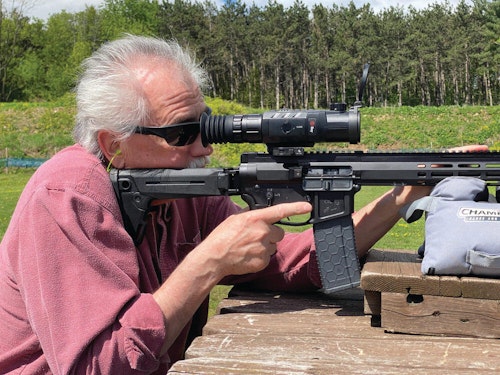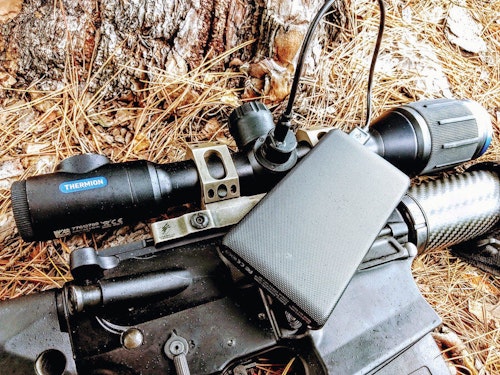I scanned the far brush line near a southeastern-Texas watering hole using a small night vision unit, waiting and hoping. Less than 10 minutes later, a good-sized boar poked his head out of the brush, paused and then made straight for the water.
I had an Armasight Contractor 25 thermal rifle scope mounted onto my Henry lever action, the rig sitting on shooting sticks. I got the hog lined up in the Contractor 25’s objective lens while my hunting guide made grunting noises to try to stop the animal. But the boar either didn’t hear the grunts or was too thirsty to care and kept trotting very purposefully toward the water, his body appearing mostly red in the thermal’s rear, ocular lens.
The hog was still moving when I took my shot at about 80 yards, the Contractor 25’s reticle lined up just below the hog’s ear. Down went the boar!
The next night, I bagged a coyote with the same setup plus helped a fellow hunter with a follow-up shot on a running and wounded cow nilgai, a free ranging exotic found in much of southeastern Texas.
Yes, it was all legal, the night hunting of hogs, coyote and exotics being a very common hunting method in Texas.
But it isn’t only Texas. Numerous other states have made the night hunting of hogs and coyotes legal as populations of both species have swelled to rather alarming numbers. This has helped spur a growing market for thermal rifle scopes and handheld thermal monoculars.
The question for the independent FFL in those states that allow night hunting: Should you consider offering thermals to your customers?
True, thermals can be very pricey, and these high-tech units will require some education for hunters and retailers alike. But the profit margins are good, and the selection of thermal options has never been better. Demand for these units keeps growing, too, as attested to by the number of companies making and selling them.
And social media appears to be a huge help in continuing to drive up the popularity of thermal night hunting.
A Decade of Thermal
I’ve used and reviewed thermal optics for just over a decade now, and when I first started doing so, I knew the technology was something special, just the thing for hunting wild hogs and coyotes at night, the time these species are most active. Thermal, for me and others, essentially created a whole new hunting opportunity.
For the hunter, thermal units were also great scouting accessories, and I’ve used these optics to find game that ran into thick vegetation and forested areas. Thermal also aids the deer hunter entering the wood at Zero-Dark-Thirty. Now, he or she can first scan the area for deer as opposed to busting up bedded animals.
Thermal also has many law enforcement applications, from game wardens tracking down night-time poachers to police and private security scanning for trespassers and doing general surveillance.
Impressed though I was with the technology, I assumed the relatively high price points of thermal would make these very much niche items, with thermal scopes often running upwards of $10,000 at the time and handheld spotting units going for $5,000 to $6,000.
I was wrong.
Driving the Market
Certain changes were just starting to make themselves felt a decade ago, and they continue to drive the thermal revolution today.
First, even as the technology of these thermal units improved, prices steadily came down. The $10,000 thermal scope of the past can be had for half of that today, with many more features, and the features are more user-friendly than ever.
Meantime, the number of feral hogs has skyrocketed in so many parts of the country. The monetary damage done by these four-footed roto-rooters to agriculture and landowners is staggering, with various sources placing the cost at over $1.5 billion annually.
This reality caused many state legislatures and game agencies to allow for night hunting of these non-native hogs and the use of high-tech optics for such hunting.
Credit social media and internet videos for some of the increased popularity of these thermal units, too. Many thermals have the ability to record video, and night hunting videos were soon (and still are) found all over the Internet and social media. The videos not only alerted people to the efficiency of this technology; they provided a kind of video game quality to the hunting experience that many have flocked to.
Add it all up and the net result is more companies than ever offering thermal optics, at lower prices, and for units that are easier to use with each passing year.
In-Store Sales
Standard features on thermal rifle scopes include various reticle options, different color “palettes,” plus photograph and video capability. Higher-end models usually have Wi-Fi and Bluetooth capability for transferring those photos and videos. Most also offer digital zoom magnification.
Power sources range from 123 lithium batteries to rechargeable batteries manufactured for specific thermal units. Battery life can range anywhere from 2 to 6 hours, depending on the unit, and many thermal scopes have the ability to connect to a power pack.
Handheld units and clip-ons won’t have the reticle options, of course, but can have most of the other features found on their scope cousins.
Darren Jones is the brand manager for Armasight, and regularly visits FFL’s who carry or are considering carrying the company’s thermal optics. While he admits that the higher price points of thermal do cause some hesitation for potential dealers, Jones adds that Armasight dealers can expect profit margins in the 20% range for his company’s units.
“We have several dealers that will move upwards of $2 to $3 million in thermals per year, and that’s for all brands, including ours,” Jones says.
Obviously, he added, these dealers have made a significant investment of time and energy to understand and know the various thermal brands and their features.
“The shops that get behind the brand, that are savvy about thermal and night vision do well with our products,” says Jones. “We can provide in-store signage, web-based and in-person training sessions, product support in the way of photos and spec sheets, and in-store sales support for demo days, too. When dealers approach us, we always try to support in some form or fashion.”
InfiRay Outdoor is another major player in the current thermal market, offering a full line of thermal optics, including its popular RICO line of thermal rifle scopes.
Angelo Brewer, director of operations for iRAY USA, the U.S. distributor of InfiRay Outdoor, noted that profit margins for their thermals are right at that 20% level, too, with some stores doing even better.
“InfiRay Outdoor has a full suite of physical support collateral available to our dealers, such as banners, POP displays (floor and counter), branded clothing, and what many describe as the best brochures in the industry,” Brewer says. “In addition to our physical support, we also offer a complete line of digital collateral and video content available on our dealer portal to support pre-sale marketing as well.”
Staff education about thermal will be a key to selling such products, and both Armasight and InfiRay Outdoor are dedicated to providing this education. Jones noted that while staff can sometimes be a little leery of this new technology, the same staffers he works with quickly grasp the core ideas behind using and selling thermal units.
“Once they understand the basic concepts, counter staff find that the various intuitive features built into our units are very easy to use,” Jones says. “And showing potential customers the ease of using Armasight thermals goes a long way to selling our products.”
Both companies sell their thermals direct to dealers and through industry distributors.
“Additionally, all of our dealers are listed on our website (irayusa.com) and we offer real-time dealer inventory availability directly on our product page as a benefit for stocking dealers,” Brewer notes.
More Tech
Understanding every bit of thermal technology would warrant a book. Maybe two.
Fortunately, the genius science types developing this technology make it for end users, and hunters don’t need a science Ph.D. to hunt hogs and yotes at night with thermal. Likewise, a retailer doesn’t need a high-flying tech degree to sell these units.
But a basic understanding of some of the numbers and functions related to thermal will help sell the units.
Thermal optics are actually cameras — digital cameras that detect electromagnetic radiation, what we non-scientists would term “heat.” So, the front lens of a thermal unit detects that heat, and that information is run through a digital sensor or “core,” which then projects the heat information to the rear or ocular lens as an image.
Of course, a great deal is going on from the front to the rear of a thermal. Again, that’s book-length information. But understanding some key points will be a big help from a sales point of view.
For consumer thermal optics, a 320x240 sensor was the baseline sensor for years and is still a very popular choice. A number of years ago, thermals built with 640x480 sensors came onto the scene. One big difference between the two sensors? Pixels.
Pixels are the very tiny, very sensitive bits of information that make up a digital photograph or image. They are usually arranged in a two-dimensional grid. So, the 320x240 thermal sensor displays an image that it 320 pixels wide and 240 pixels high. Which means there are 76,800 pixels present in an image seen through a thermal optic using a 320x240 sensor.
A 640x480 unit has four times the number of pixels in the image versus a 320x240 unit, so the 640 sensor units in effect provide four times the information for much more detailed images. A 640 will usually have a larger objective lens than 320 units, too, and a larger objective plus quadruple pixels provides clearer images and a wider field of view.
Most thermal units are operated with a menu system. A button is pressed or a turret is turned to enter the main menu, and then the user scrolls down that menu to the various applications within the unit.
For example, a thermal rifle scope will need to be zeroed. The user would enter the main menu and then scroll down the ZERO function and open it. Much like a daytime optic, many thermal scopes allow the user to move the bullet’s point of impact by shifting the reticle’s elevation and windage controls.
Most newer thermals I’ve used also let you take a shot or two at a target, and then shift the reticle to where the shots hit. Lock that reticle position into place, aim for the bullseye with the next shot and you should be right on target.
Show a potential customer the ease of using a thermal scope’s zeroing process and let them tool through a few menus and scope out various heat sources in your store (like people, that spot on the floor in full sun, etc.), and you may well have just sold a thermal unit!









